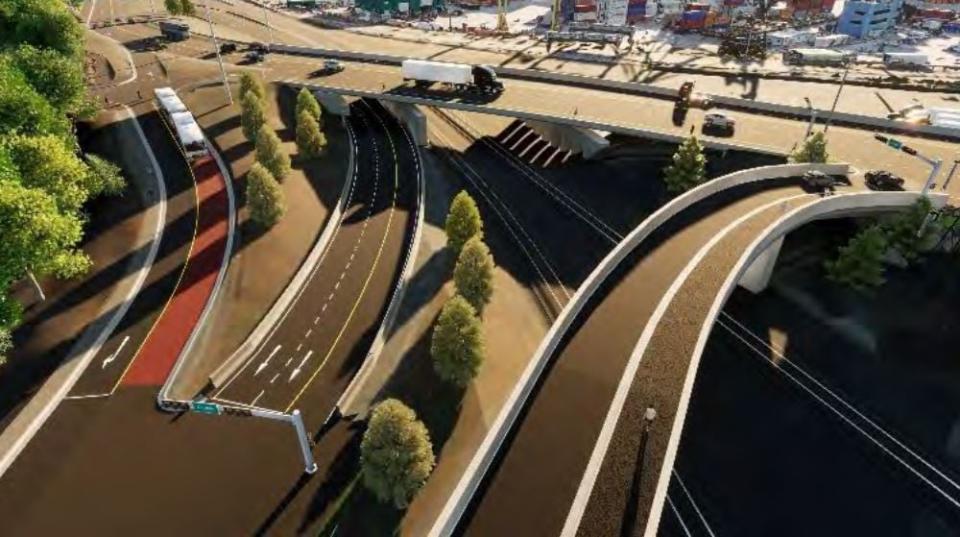Windsor Street exchange redesign moves ahead despite rising cost, transit concerns
After years of planning, Halifax is moving ahead with changes to the Windsor Street exchange to improve traffic flow, but the projected cost is rising and councillors are asking for bus lanes to be worked into the design.
On Tuesday, regional council green-lit the high-level plan that staff said improves traffic for everyone, and allows cyclists and pedestrians to more safely pass through the area, which handles around 110,000 vehicles a day.
The project began in 2021 when the federal government announced $23 million to address the traffic bottleneck, while specifically helping trucks get in and out of the Fairview Cove container terminal more easily.
"Anything is better than what's there now, so this is great work, with some possible changes that I think could improve it," said Coun. Lindell Smith.
A key change allows for free-flowing traffic between the Bedford Highway and the MacKay Bridge, bypassing the main intersection.

Drivers heading from the peninsula to Bedford would use a new underpass between Lady Hammond Road and Bayne Street. Direct access to the Bedford Highway would be removed from Windsor Street, which would only connect to Highway 111 bound for the MacKay Bridge or Lady Hammond.

A second outbound lane would be added to the exit ramp from Bedford Highway to Joseph Howe Drive. A set of traffic lights would be added to the ramp from Joseph Howe Drive to the exchange and Bedford Highway to better control traffic flow and protect people walking or cycling.

The city is also asking Transport Canada to extend its deadline for project completion to the end of 2027 so Halifax can still collect the original $23 million. Staff said the project area was greatly expanded to take into account nearby areas that affected the Windsor Street exchange.
The costs jumped because of this expansion, inflation, and Halifax Water upgrades to handle planned density in the area. The original $50-million price tag is now $103.8 million.
Halifax is covering the difference, bringing the city's cost from $10 million to $67 million — which is 65 per cent of the project. The city was originally paying 23 per cent.
Staff said they would explore sharing the cost with other levels of government, but nothing has been finalized.
"We somehow have to figure a way with provincial and federal governments so that we don't get stuck paying for all the [costs]," said Mayor Mike Savage.
"It may not be as good a deal now … but it's something we need."
Traffic delays would be most improved in the morning
A staff report said the new design increases vehicle traffic by about 1,200 vehicles, or 12 per cent, during peak morning hours and by 800, or 8 per cent, in the afternoon. That would help better handle the city's growing population, the report said, which is expected to result in 30-40 per cent more traffic demand by 2031.
It would also reduce all traffic delays by about 46 per cent in morning rush hour and 10 per cent in the afternoon.
There would be transit-only lanes in some areas and a multi-use path for cyclists and pedestrians to transit through the site.

But Smith and other councillors said that doesn't go far enough at a time when the city is trying to encourage more transit use, and planning for a bus rapid transit network that would include a route through the Windsor Street exchange.
"I don't see how we could spend this much money and not have designated bus lanes all the way through the site," said Coun. Waye Mason.
Active transportation advocates have also said bicycle lanes should be separate from pedestrian paths and traffic in the design, which staff said they weren't able to achieve.
Megan Soroka, a project manager with HRM, said they were constrained by the layout of the area given the container terminal on one side and cemetery on the other. Reducing traffic lanes to create that bus lane could also slow trucks down, and cause the city to lose the federal funding, she said.
The planned transit priority measures and overall changes would reduce transit delays during peak times to an average of under two minutes, the report said.
"There are tradeoffs," Soroka said. "We have tangible improvements for all modes of travel but we also have impacts."
While council approved moving ahead, and directed staff to hire a team to handle the detailed design and build of the project, they also asked that bus lanes and other active transportation improvements be considered.
"Give us every square foot of bus lanes that you can," said Mason.
Staff will come back to council in a few months once that detailed design is nearly finished. Construction is set to begin in 2025.
MORE TOP STORIES

 Yahoo News
Yahoo News 
